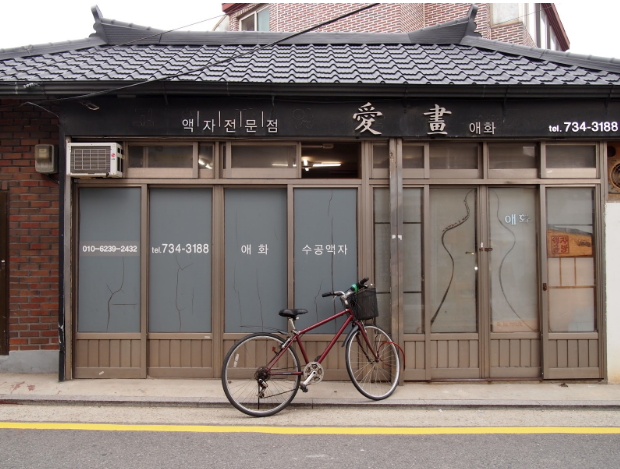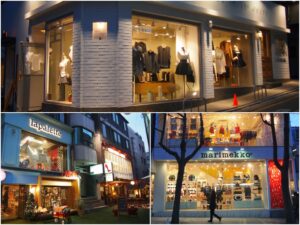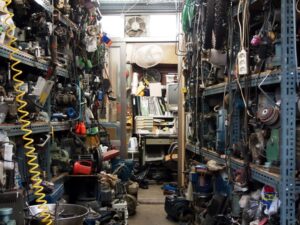Stretching from the western gate of Gyeongbokgung Palace to the base of Inwang Mountain, it is an area made up of fifteen compact neighborhoods that seem to have dodged the modernization that has affected the remainder of the city. Here, clusters of traditional homes crowd tiny alleyways that have winded through the district for centuries.
While parts of Seochon Village have been converted into commercialized areas, the neighborhood, as a whole, retains its traditional aesthetic. Unlike nearby Samcheongdong, Seochon lacks coffee franchises and crowds, boasting more private, cozy spots that remain more or less a secret to Seoulites.
A Royal Walk Through Time
From exit 5 of Gyeongbokgung Station, you will emerge right into the main palace of Seoul, which is worthy of an afternoon visit on its own. But for now, start your walking tour of Seochon at the National Palace Museum of Korea, which opened in 1992 and boasts over 20,000 royal artifacts from Korea’s royal sites.
Uncover the secrets of the kings and queens through various exhibits, which are themed around ancestral rites, palace architecture, the sciences of the Joseon dynasty and royal life.
Try a cup of mogwacha (quince tea) and royal tteokbokki, a mild version of the popular street food of today, at Gogung Tteurak (고궁뜨락) on the first floor to experience a bit of cuisine that was favorited by Joseon royalty.
Exit Gyeongbokgung, make your way along the picturesque palace wall and explore the alleys of Tongui-dong Hanok Village (통의한옥마을), the former home of several famous figures including painters Yi Jung-seop and Yi Sang-beom, and poets Yun Dongju and Yi Sang. The majority of these remaining homes are gaeryang hanok, which were largely constructed after the 1910s in accordance with a government housing plan.
Most notable are the wonderful early 20th century doorways, adorned with elaborate metal fittings that spill into courtyards, a trademark of hanok architecture. Some of these structures have been converted into European bistros and independent cultural spaces, including Jean Art Gallery.
This space, which hosts both individual and collaborative exhibitions, is a pioneer of the neighborhood gallery scene. Since 1972, it has promoted contemporary Korean artists in Japan, as well as Japanese artists, such as Kusama Yayoi, in Seoul.
Established in 2003, the small yet intimate Brain Factory is a non-profit exhibition space dedicated to promoting Korean contemporary art and artists. It also functions as an open studio for young artists to cultivate their creativity and confidence through a variety of workshops and training programs. Exhibits, which range from sculpture to photography, are constantly changing and guests are encouraged to browse the works on display at their own pace.
If furniture is more your thing, head down the street to MK2. Two designers run this chic establishment that borders between a gallery and a cafe. Its modern interior is bright and minimalistic, with a focus on its furniture, which changes frequently. Yet, unlike many gallery-cafes, MK2 has a really great menu. Order a radler or a glass of sangria as a pre-lunch apéritif.
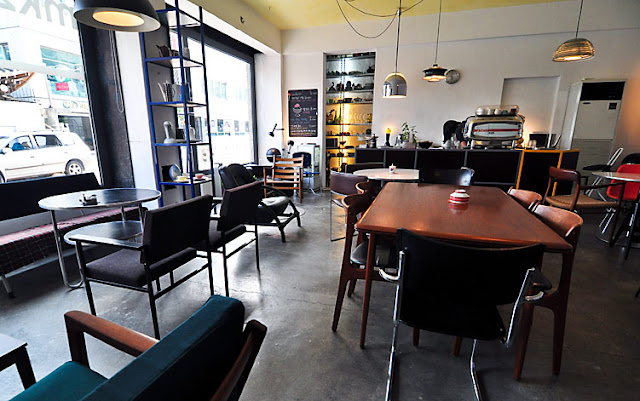 |
| Photo |
A Taste of The Past
Korea’s traditional markets, which were once on the brink of extinction thanks to the influx of supermarkets and discount stores, have been revived in recent years as a result of an increase in interest in all things traditional. Nowhere can one better experience the vibrancy of these cultural relics than at Tong-in Market, which draws in crowds with its Doshirak Cafe.
This bare bones dining locale gives visitors the rare opportunity to sample a wide selection of Korea’s most iconic cuisine, from dubu buchim (pan fried tofu) to various types of jeon (savory pancakes). Grab a doshirak (lunch box) and a handful of tokens for 5,000 won on the second floor, and exchange the coins for traditional tasty treats, allowing the aromas to lead you from stall to stall.
Walk through the market and take a left onto yet another historical Seochon street that hasn’t seen many significant changes over the years, with many of the businesses having been established for decades.
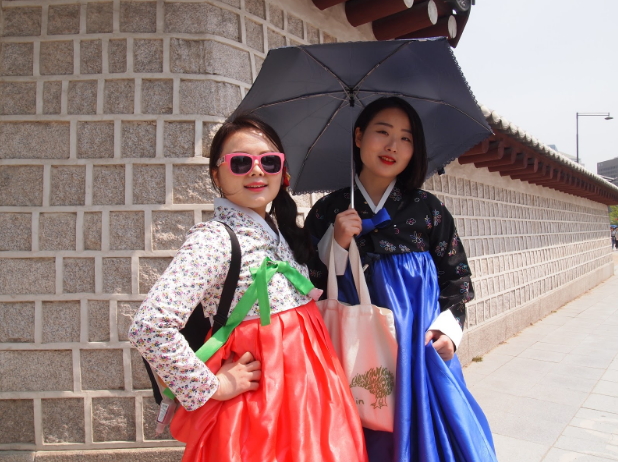
Dae-oh Book Store 33 Cafe, for example, is the oldest second hand bookshop in Seoul, having opened its doors in 1951, and its worn signboard and rickety yet charming facade validate this fact. After the owner passed away, his wife, Kwon Oh-nam, decided to keep the store open for business and it has since transformed into a cafe that is a popular filming location for dramas such as “Sangeo (Shark)”, starring Son Ye-jin and Kim Nam-gil.
Despite the changes, the cafe still resembles the bookstore it once was and has incorporated the original furniture and knick-knacks of the family. Hanji (Korean paper) dolls, an antique wardrobe, wooden sticks once used for ironing and black and white photos all contribute to the homey and nostalgic atmosphere. Order a cup of watermelon juice—the cafe’s signature beverage—and have it served up with a stick of dalgona, old-fashioned Korean candy made from burned sugar.
For something a bit healthier, try the traditional teas at the Tongin Herbal Medicine Dispensary (통인한약국), where two pharmacists will choose the best medicinal herbs for you based on your ailment, whether it be a cold, achy joints or exhaustion (which you might just be experiencing after all your Seoul searching!) It’s hard to miss this traditional gem… just follow the strong but pleasing scent of herbal medicine.
An ideal spot for an afternoon meal, The Story of Lotus (연이야기) serves lunch sets similar to Japanese bento boxes using fresh, local ingredients with a focus on one: the lotus.
Inspired by the beauty and freshness of the flower at a global garden expo, the owner decided to incorporate the flavor into the restaurant’s dishes, which are a healthy alternative for local office workers looking for a quick to-go meal.
Visitors can also dine in at this bright and homey restaurant and will most certainly appreciate the ceramic ware on which dishes like doenjang (fermented bean paste) soup, kimchi, and Hamyang lotus leaf wrapped rice is served. For a few extra thousand won, diners can upgrade their meal to sample delicate Korean sweets which are beautifully presented as if they were small morsels of art.
A Stroll Among Shops
Swing back around to a Seochon street that has been more commercialized, but still maintains its old world charm. It feels quite similar to Garosu-gil and Gyeongnidan-gil, but with far better prices and smaller crowds. Even if you’re not in the mood to shop, Seochon boasts a slew of charming gift stores owned by friendly proprietors. Clustered together, it’s easy to walk from one to the next and window shop without feeling pressured to make a purchase.
Ladies will love the tiny boutiques, such as Sugamo, which sells gorgeous bags and scarfs, and Kim’s Boutique, which has a great selection of colorful women’s dresses with a haute hippie look, designed specifically by the brand’s owner. Zenana Jam is a tiny shop that specializes in a variety of preserves and scones that you’re unlikely to find anywhere else, with flavors such as strawberry curd, green tea milk and garlic. Whether you prefer sweet or savory, there’s a variety for you.
Further along the road, Tomoro (short for Today is More Romantic) sells a nice selection of eco-bags, candles and diffusers. Woo Yeon Soo Jib is another favorite of design fanatics. Though on the smaller side, its wares are eclectic and have all been created by local artists. The shop’s fanciful ferris wheels in the window lure in visitors, and its utterly adorable furry lamas and creative playing cards make for great gifts.
Life’s Simple Pleasures
Stop in at nearby Flower & Cafe do, a flower shop/cafe housed in a remodeled Korean traditional house. As soon you step inside the door, your mind will be put at ease, thanks to the greenery that colors the room and the scent of fresh flowers that perfume the air. Seemingly straight out of a story book, this enchanting cafe is a nice spot to relax and watch couples and families as they pass.
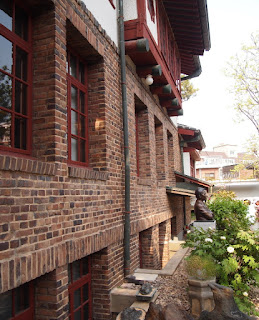 After experiencing the contemporary contributions of today’s young, hip artists, see how the neighborhood became a hub of Seoul’s art scene. Just around the corner from Flower & Cafe do is the Park No-soo Art Museum, a structure so unexpected and strikingly different from its surroundings that it will elicit a double take… or two. This impressive red-brick home was built in 1937 combining Korean, Western and Chinese architectural styles, and was the residence of the renowned Korean painter Park No-soo.
After experiencing the contemporary contributions of today’s young, hip artists, see how the neighborhood became a hub of Seoul’s art scene. Just around the corner from Flower & Cafe do is the Park No-soo Art Museum, a structure so unexpected and strikingly different from its surroundings that it will elicit a double take… or two. This impressive red-brick home was built in 1937 combining Korean, Western and Chinese architectural styles, and was the residence of the renowned Korean painter Park No-soo.
Donated to Jongno District Office, along with his private collection, it has since become a cherished museum open to the public. Park’s unique style of concise and bold brushstrokes and vivid colors merge with traditional subjects, creating a perfect harmony of the old and the new, much like Seochon itself.
Purchase a ticket outside the house to get access to a selection of his paintings inside the home, which is decorated with Park’s own personal belongings. Just as impressive as the structure is the garden that traces its periphery. Admire stone statues, relax at the pond, or climb up the hill to get an ariel view of the neighborhood.
Tosokchon Samgyetang, a Seochon institution that is without a doubt the purveyor of ginseng chicken soup, is the perfect way to wrap up your visit to Seochon. Using only domestic ingredients, the beautifully designed restaurant with a seating capacity of over 400 attracts diners from all over the country, from presidents to pedestrians curious about the long lines.
The revitalizing samgyetang, which is made with a whole young chicken, glutinous rice, gingko nuts, ginseng, garlic and jujube, as well as 30 different types of medicinal herbs and grains, is especially popular in the summer, as its ingredients are believed to protect the body and mind from the intense Korean heat.
Alternatively, Sejong Village Food Street (also known as Geumcheongyo Market) is a lively place to wander at dinner time, as it is one of the go-to drinking areas of local office workers. This tiny alleyway is chock full of small restaurants with seating that spills out onto the street. Keep an eye out for the elderly woman who stells tteokbokki from an open-air stall with only a stove and a few boxes… trying her version of the street food might will undoubtedly be a memorable experience. Restaurants such as BeeZza, where you can get great pizza and local craft beer, shows the contemporary side of this age-old market area that is ever-developing.
While the new elements of the neighborhood are attractive, the best part about Seochon is its rich history and, as such, should be greatly appreciated, respected and cherished by visitors.
To Get There: Take the Seoul subway to Gyeongbokgung Station (Line 3, Exit 5).
More Neighborhoods Like This: Gyeongnidan/HBC; Samcheongdong
Nearby Neighborhoods: Insadong; Buamdong; Samcheongdong
Map:
Words and photos by Mimsie Ladner of Seoul Searching. Content may not be reproduced unless authorized.


